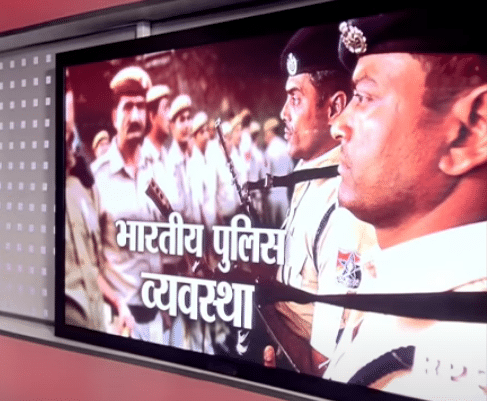Introduction to Indian Police System
Welcome to the world of Indian police! If you’re curious about how law enforcement works in India, you’ve come to the right place. As part of the Indian Constitution, police forces are responsible for a wide variety of duties, such as preventing and investigating crimes, maintaining law and order, protecting life and property, and using their power and authority in a professional manner.
The police force has been active in India since 1861 when the first Police Act was enacted by the British Government. Since then, several amendments have been introduced to modernize and improve the functioning of the police force. Today’s police have been equipped with sophisticated technology as well as updated training methods to improve their efficiency.
It is important to remember that every action taken by police officers must be in accordance with established laws and procedures. Even though they are authorized to use their power and authority for dealing with offenders or criminals, they must never do so indiscriminately or abuse it for personal gain.
In addition to crime prevention and investigation activities, Indian police are also responsible for controlling riots, managing traffic during festivals or demonstrations, protecting public property during natural disasters such as floods or earthquakes, providing assistance to victims of accidents or serious crimes like trafficking or sexual assault etc., In addition they provide security at critical infrastructure such as airports, nuclear/power plants etc.,
To conclude, our country’s police force is incredibly important for keeping society safe from crime and ensuring law & order prevails everywhere. By understanding their respective roles within the Indian Constitution; we can appreciate how we all can contribute towards making our country safer & better for all citizens.
History of Indian Police System
The history of the Indian police system is an important and complex one, tracing its roots back to colonial rule. When the British colonized India, they imposed a police system that was heavily militaristic and authoritarian. This system was meant to control and oppress the population, a legacy that continues in some parts of India today.
The emergence of modern policing in India began with the introduction of the Indian Police Act of 1861. This Act introduced professional standards for policemen, as well as establishing a system for investigating crimes and ensuring civil rights were respected. After independence in 1947, there was an effort to reorganize India’s police forces into statelevel police departments.
Since then, these state police forces have been joined by several paramilitary forces, such as the Central Industrial Security Forces (CISF) and Border Security Force (BSF). The role of the Supreme Court has also been instrumental in introducing reforms to this system, such as during the landmark judgment in 1997 which led to the passing of The Protection of Children from Sexual Offences Act (POCSO) or UNCRCP Act .
Today’s Indian police forces combine traditional law enforcement techniques with modern advances in technology and forensics. They are responsible for protecting citizens from crime and upholding justice across India. It is an important job that often goes unrecognized, but it is one worth knowing about if you want to know how law enforcement works in India.
The Structure of the Indian Police System
Welcome to India, a land of diverse cultures and traditions. But perhaps one of the most important aspects of the nation is its police force. It is the primary law enforcement agency that handles daytoday policing and maintaining law and order across the country. Let’s take a look at how the Indian Police force is structured and how it works.
The Indian police system is divided into two parts state level and district level forces. At the district level, there are sub divisions that are further divided into rural and urban areas. The police force of each district is headed by a Superintendent of Police (SP). He or she is responsible for ensuring law and order in their respective region.
At the state level, there are Police Commissionerates which act as umbrella organization for all police stations in their respective states or union territories. The Police Commissionerates are headed by an Inspector General of Police (IGP) who exercises powers over both uniformed officers as well as nonuniformed staff. Each state also has its own independent wings like Crime branch, Special branch, Home Guard etc depending on their particular needs.
The roles assigned to officers depend on various factors such as rank, experience, qualifications etc. For example, a Sub Inspector can be assigned duties like investigating crime scenes or conducting raids while an Assistant Sub Inspector may handle traffic related issues such as issuing challans or helping out with other administrative tasks.
The powers granted to officers vary depending on their particular jurisdiction and area of expertise but some generally accepted powers include the ability to make arrests, search property without a warrant if necessary, seize items believed to be evidence etc. These powers can only be exercised when absolutely necessary and always by following due process laid down
Roles and Responsibilities of Indian Police
Police officers are everywhere in India – but do you know exactly what their roles and responsibilities are? Many people assume that the police simply enforce laws and protect citizens, but the reality is that their jobs entail much more than just that. From law enforcement to crime investigation, traffic management to corruption control, there is a wide range of tasks and duties undertaken by Indian police forces.
Let’s take a closer look at the various roles and responsibilities of India’s police. Firstly, they help maintain public order and safety by ensuring that laws are followed and that citizens feel protected in their communities. In addition to this, they also investigate crimes, such as theft, fraud or assault, which aids in apprehending the perpetrators and bringing them to justice. They also handle emergency situations such as fires or natural disasters by directing traffic away from hazardous areas or controlling crowds so as to minimize disruption.
Moreover, Indian police also work hard at preventing any potential breakdowns in public safety due to unforeseen circumstances. As part of this role, they assist with crowd control during large festivals or political gatherings where tensions may be running high. Furthermore, their duty is also towards providing protection for citizens; for example, protecting individuals from physical harm or abuse by patrolling neighborhoods or responding quickly if an emergency such as a home invasion occurs.
Other activities include managing general traffic flow (such as coordinating traffic signals) as well as combating corruption and illegal activities in the country. This usually entails keeping tabs on drug trafficking routes, money laundering schemes and other criminal operations while engaging in preventive measures such as surprise raids at suspected hideouts to ensure these activities don’t grow unchecked.
Last but not least are the duties of Indian police forces related
Challenges Facing the Indian Police System
As you probably already know, the Indian police system has faced a number of challenges over the years. From colonialera policing to a corrupt and outmoded system, the issues facing this vital law enforcement institution range from lack of resources and manpower to inadequate training and access to justice. The result is a situation where officers are often misusing their powers and authority in ways that harm rather than protect those they are meant to serve.
The lack of modernization within the Indian police force has been one of their greatest handicaps. With outdated equipment and procedures, it’s no surprise that officers don’t always have access to the latest technology – or even enough personnel – required to effectively do their job. This has in turn resulted in a woefully low rate of crime prevention and detection; many serious crimes go unsolved due largely to inadequate resources for investigation.
Training within the force is also sorely lacking; without proper instruction, officers are unable to effectively enforce the law or foster public safety. Furthermore, many lack any formal knowledge or understanding of their legal rights when conducting arrests or detaining suspects. This means that too often rules are disregarded with impunity, leading to violations of human rights and exacerbating existing grievances within communities who receive inadequate protection services from the police.
Finally, access to justice within India remains inadequate despite years of progress in other areas such as development and education. Defendants can be held for months or even years before they’re given a court hearing; victims often face an uphill battle when seeking accountability while officials remain unaccountable for misconduct that goes unpunished or underpunished. Without meaningful laws in place protecting citizens’ rights, there’s little incentive for individuals to seek justice through legal
Laws and Regulations Guiding the Indian Police System
If you are new to the Indian Police system, then you must be wondering how the police work in India. Well, the enforcement of laws is guided by a set of laws and regulations that have been laid down by the government authorities to ensure that police work is done efficiently and ethically. These laws provide guidance for police officers in their day-to-day operations, from the types of arrests they can make and evidence they can collect, to how they should handle citizens and their rights.
It is essential for police officers to be familiar with these laws so that they can properly perform their duties as law enforcement officers. As per the law, any citizen has the right to call upon a police officer if he/she witnesses a crime or if he/she has reason to believe that a crime has been committed. In such cases, it is mandatory for a police officer to intervene and take appropriate steps.
The law also states that any citizen who feels wronged by the actions of a police officer can file a complaint against him/her with higher authorities. It is important to note here that all complaints must be filed within six months of the date on which the alleged wrongful action took place. Filing a complaint will enable higher authorities to investigate the matter appropriately and take necessary steps as deemed fit by them.
Apart from these rules, there are other guidelines laid down for proper functioning of police personnel in India. For example, all officers must conduct themselves according to proper code of conduct while participating in any law enforcement activities such as arrest, search or seizures or investigations etc. Similarly, it is mandatory for all policemen to wear their uniforms at all times so as to identify themselves as members of law enforcement agencies easily.
Recent Developments in the India Policing Systems
Are you interested in understanding the recent developments in India’s policing systems? If so, you’ve come to the right place! The laws and reforms that are governing police forces across India have been changing over the past few years, and these changes affect how police works in India.
Law Enforcement: Police Reforms
The government has been focusing on implementing effective police reforms to ensure better law enforcement. These reforms focus on creating a more efficient and competent police force that is able to respond quickly and provide adequate solutions to the problems faced by citizens. To this end, the government has launched initiatives such as introducing new recruitment methods, reforming the investigating system, improving the training process for officers and introducing new measures against corruption.
These initiatives have been designed to improve the overall quality of service provided by the police force. Additionally, they aim to ensure that police officers have more access to technology and resources which aid them in their investigations. As a result of these reforms, there has also been an increased focus on accountability within the system which is monitored through extensive reporting systems.
To ensure effective implementation of reforms, various committees have been established by the government with representatives from different departments such as judiciary, media, civil society organizations who are responsible for monitoring the progress of these reforms. Additionally, several states are introducing digital tools such as CCTV cameras and surveillance drones to aid in investigations and tracking criminals.
The government is also striving towards enhancing cooperation between law enforcement agencies across states to effectively address cross-border crimes. All these initiatives taken together are contributing towards a stronger India where citizens feel safe and secure knowing that their law enforcement will be able to fulfill its duties effectively.
Strengths and Weaknesses of the Indian Policing System
The Indian policing system has its strengths and weaknesses, and it’s important to understand both in order to evaluate how the police work in India. To start with, the colonial heritage that still lingers in India today has hampered the system’s development. This has led to limited resources that are allocated to law enforcement, which can make it difficult for them to do their jobs effectively. Complicated laws also add a layer of difficulty for police officers in India. In addition, there is often low integrity and accountability within the system which can lead to corruption and unethical behaviors among officers.
Perhaps one of the most pressing issues when it comes to Indian police are their working conditions: they are often overworked, underpaid, and lack proper training and modern equipment. This can lead to poor decision-making and ineffective policing practices. Furthermore, many of the systems and procedures used by Indian police are outdated, making them slower and less efficient than they should be. Finally, there is an overall underdeveloped infrastructure when it comes to Indian policing, making it difficult for officers to access resources quickly or efficiently.
Overall, there are significant strengths and weaknesses in the Indian policing system which need attention from policy makers so that officers have adequate resources available for them to perform their duties properly. A modernization of laws should also be considered so that officers can better understand how best to enforce them as well as increase transparency within the system by improving accountability measures for officers. Additionally, efforts must be made towards providing better training methods and modern equipment so that police officers can do their jobs more safely and efficiently. Finally, investments into infrastructure should be increased so that law enforcement can access necessary resources quickly when needed.
Bibhu Mishra is a prolific writer who has published many books spanning various genres. He is a legal enthusiast and an avid researcher of cutting-edge technology, diving into fascinating realms to bring captivating narratives to life.



